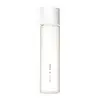What's inside
What's inside
 Key Ingredients
Key Ingredients

No key ingredients
 Benefits
Benefits

 Concerns
Concerns

 Ingredients Side-by-side
Ingredients Side-by-side

Water
Skin ConditioningButylene Glycol
HumectantGlycerin
HumectantDiglycerin
HumectantPropanediol
SolventPPG-24-Glycereth-24
EmulsifyingPhenoxyethanol
PreservativeGlycosyl Trehalose
Emulsion StabilisingPEG-75
HumectantPolyglyceryl-10 Eicosanedioate/Tetradecanedioate
Skin ConditioningHydrogenated Starch Hydrolysate
HumectantMethylparaben
PreservativePEG-400
Emulsion StabilisingCarbomer
Emulsion StabilisingXanthan Gum
EmulsifyingPotassium Hydroxide
BufferingCentaurea Cyanus Flower Extract
AstringentPrunus Persica Leaf Extract
EmollientTilia Cordata Flower Extract
Skin ConditioningZostera Marina Extract
Skin ConditioningWater, Butylene Glycol, Glycerin, Diglycerin, Propanediol, PPG-24-Glycereth-24, Phenoxyethanol, Glycosyl Trehalose, PEG-75, Polyglyceryl-10 Eicosanedioate/Tetradecanedioate, Hydrogenated Starch Hydrolysate, Methylparaben, PEG-400, Carbomer, Xanthan Gum, Potassium Hydroxide, Centaurea Cyanus Flower Extract, Prunus Persica Leaf Extract, Tilia Cordata Flower Extract, Zostera Marina Extract
Water
Skin ConditioningDiglycerin
HumectantGlycerin
HumectantTranexamic Acid
AstringentButylene Glycol
HumectantPEG-8
HumectantPEG-6
HumectantPEG-32
HumectantPPG-24-Glycereth-24
EmulsifyingMethylparaben
PreservativeCarbomer
Emulsion StabilisingPolysorbate 20
EmulsifyingStyrene/Vp Copolymer
Disodium EDTA
Hydrolyzed Hyaluronic Acid
HumectantMagnesium Ascorbyl Phosphate
AntioxidantTocopherol
AntioxidantSodium Hyaluronate
Humectant
 Reviews
Reviews

Ingredients Explained
These ingredients are found in both products.
Ingredients higher up in an ingredient list are typically present in a larger amount.
Butylene Glycol (or BG) is used within cosmetic products for a few different reasons:
Overall, Butylene Glycol is a safe and well-rounded ingredient that works well with other ingredients.
Though this ingredient works well with most skin types, some people with sensitive skin may experience a reaction such as allergic rashes, closed comedones, or itchiness.
Learn more about Butylene GlycolCarbomer is a polymer of acrylic acid. Its main role is to create a gel consistency.
A high amount of carbomer can cause pilling or balling up of products. Don't worry, most products contain 1% or less of carbomer.
Diglycerin is a humectant. It is derived from glycerin, which is naturally found in your skin.
As a humectant, it helps draw moisture to the skin from the air.
Glycerin is already naturally found in your skin. It helps moisturize and protect your skin.
A study from 2016 found glycerin to be more effective as a humectant than AHAs and hyaluronic acid.
As a humectant, it helps the skin stay hydrated by pulling moisture to your skin. The low molecular weight of glycerin allows it to pull moisture into the deeper layers of your skin.
Hydrated skin improves your skin barrier; Your skin barrier helps protect against irritants and bacteria.
Glycerin has also been found to have antimicrobial and antiviral properties. Due to these properties, glycerin is often used in wound and burn treatments.
In cosmetics, glycerin is usually derived from plants such as soybean or palm. However, it can also be sourced from animals, such as tallow or animal fat.
This ingredient is organic, colorless, odorless, and non-toxic.
Glycerin is the name for this ingredient in American English. British English uses Glycerol/Glycerine.
Learn more about GlycerinMethylparaben is a preservative and is a paraben. It is used to prevent the growth of fungus, mold, and other harmful bacteria. Parabens are chemicals used as preservatives in both cosmetics and food.
Methylparaben can be synthetically created. It can also be found naturally in some fruits, such as blueberries.
Oftentimes, Methylparaben is combined with other parabens to help increase the shelf life.
The safety of Methylparaben is currently being studied. While ongoing studies are looking into the safety of parabens, the results have been very mixed. Some studies have not found Methylparaben to be harmful.
Learn more about MethylparabenWe don't have a description for PPG-24-Glycereth-24 yet.
Water. It's the most common cosmetic ingredient of all. You'll usually see it at the top of ingredient lists, meaning that it makes up the largest part of the product.
So why is it so popular? Water most often acts as a solvent - this means that it helps dissolve other ingredients into the formulation.
You'll also recognize water as that liquid we all need to stay alive. If you see this, drink a glass of water. Stay hydrated!
Learn more about Water